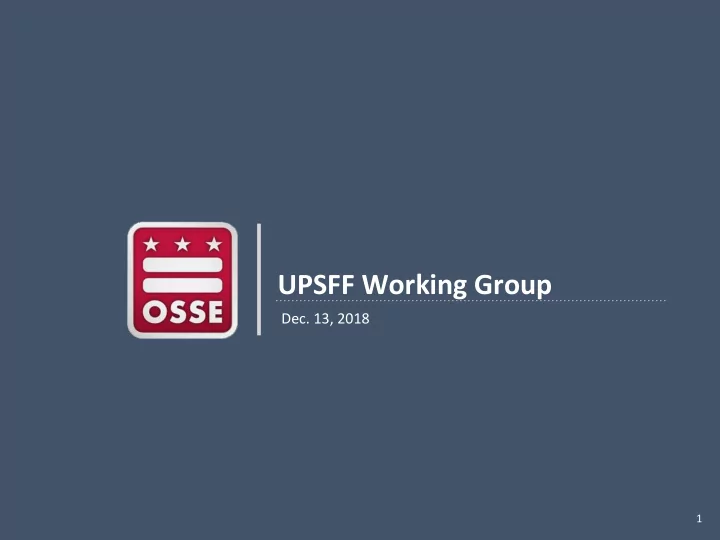

UPSFF Working Group Dec. 13, 2018 1
Agenda • Welcome and Introductions (5 min) • Timeline Overview (5 min) • Draft Recommendations 1 and 2 (45 mins) • Feedback review • Discussion questions • Draft Recommendations 3, 4 and 5 (15 mins) • Feedback review • Discussion questions • Public Comment Period (15 min) • Up Next (5 min) 2
Timeline Overview: Working Group Goals • Responsibilities of UPSFF working group : • Provide input and develop recommendations regarding revisions to the UPSFF • Goals for the working group: • Examine the UPSFF and district-wide budgeting in practice (August) • Revisit Adequacy Study of education costs in the District (September) • Review national landscape, including research in education and education finance (October) • Develop recommendations regarding revisions to the UPSFF on the focus area categories: At Risk, ELL, and SPED (October, November and December) • Workshop report recommendations ahead of January publication (December) 3
Timeline Overview AUG SEPT OCT NOV DEC Introductory Meeting Monthly Group Meeting Monthly Group Meeting Monthly Group Meeting Review Recommendations UPSFF Review Process, UPSFF Adequacy Study Review, Focus National Landscape Review Focus Area Discussion and Overview, and Focus Area Area Selection Follow Ups from Adequacy Deep Dive Review and Comment on Draft Introduction Study Review Preliminary Recommendations Recommendations Focus Area Overview and Deep Dive on At Risk 4
Draft Recommendation 1 Draft Recommendation 1: DC should minimize the gaps between the current foundation amount, current At Risk weight, and current English Language Learner weight, and those amounts and weights as recommended in the Adequacy Study, taking into account any discrepancies between the Adequacy Study definitions and the definitions as implemented by the law. 5
Draft Recommendation 1 Discussion Questions Are the Adequacy Study recommended base and weights the right ● targets for formula revisions? How does the group feel about tying to a specific amount? ● What does the working group recommend in regard to increasing ● the foundation and/or the at risk and English Learner weights in the context of flat or declining revenues? What is the priority between these should a choice have to be made? Is this recommendation (to increase funding to a specified level) ● more or less important than Recommendation 2 (to offer predictability year over year), particularly if faced with flat or declining revenues? Is recommending a more targeted analysis based on funding gaps ● sufficient or is the group recommending another full Adequacy Study? 6
Draft Recommendation 2 Draft Recommendation 2: DC should consider one or more solutions from a menu of options to make foundation increases more predictable for LEAs. ● Option 1: Tie foundation increases to an inflation measure that takes DC costs into account. ● Option 2: Consider a floor percentage increase each year, provided revenue reflects the city’s ability to cover the increase. 7
Draft Recommendation 2 Discussion Questions ● Is Option 1 preferable to Option 2? Can they be combined? ● Is this recommendation (to offer predictability year over year) more or less important than Recommendation 1 (to increase funding to a specified level)? ● What does the working group recommend in the context of flat or declining revenues? ● Should the facility allotment be included in either option? 8
Draft Recommendation 3 Draft Recommendation 3: UPSFF revisions should consider one or more solutions from a menu of options to address schools’ high at-risk concentrations, requiring additional concentration funding to follow the student to the school. Option 1: Implement an additional school concentration weight: ● Account for concentration at the school level via an additional student-based at-risk concentration weight, on top of the existing at-risk weight, once that school hits a “tipping point” percentage of at-risk students. Option 2: Fund the highest concentration schools differently: ● Account for concentration at the school level by funding schools at 100% at-risk once that school hits a “tipping point” percentage of at-risk students. 9
Draft Recommendation 3 Discussion Questions ● Should Option 2 be removed as it treats those just over the tipping point the same as those schools that are at 100%? 10
Draft Recommendation 4 Draft Recommendation 4: UPSFF revisions should consider funding certain at risk characteristics higher than others, requiring the additional funding to follow the student to the school. The UPSFF should include an additional at risk weight based on higher relative need for certain characteristics (i.e., CFSA, homelessness) on top of the already received at risk weight funding for all five definition categories. 11
Draft Recommendation 5 Draft Recommendation 5: The UPSFF’s English Language Learners (ELL) and special education weights should be considered for revision only once more analysis has been completed on the costs to serve subgroups within those groups and the outcomes for each. Specifically, the analysis should determine if the English Language Learner weight should be tiered, and along what line of differentiation. 12
Public Comment • Time for non-members to provide feedback or comments 13
Up Next • Draft Report to be circulated by COB Wednesday, December 19th • Final comments due by COB Wednesday, January 2nd • Working group virtual meeting Thursday, January 3rd, 3:30-4:30 (optional) • To discuss any final feedback before submitting report 14
Recommend
More recommend